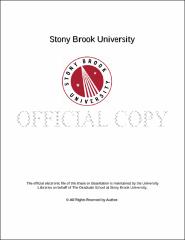| dc.identifier.uri | http://hdl.handle.net/11401/77567 | |
| dc.description.sponsorship | This work is sponsored by the Stony Brook University Graduate School in compliance with the requirements for completion of degree. | en_US |
| dc.format | Monograph | |
| dc.format.medium | Electronic Resource | en_US |
| dc.language.iso | en_US | |
| dc.publisher | The Graduate School, Stony Brook University: Stony Brook, NY. | |
| dc.type | Dissertation | |
| dcterms.abstract | This dissertation discusses how literary writers of the Victorian age render toxicity and toxic behaviors visible in order to encourage reform, as well as offering models of healthy environmental engagement. This literary trend reveals what I call a rising eco-consciousness, the awareness of our relationship to the environment and the exchanges between human and nonhuman. This project emphasizes the novel, which offers a rich ground of inquiry by looking at a set of characters interacting with a space over time; in other words, it focuses on how authors mapped a complete ecology into their fiction, participating in a genre that I call " natural realism." Literary responses to pressing ecological problems, particularly air and water pollution and deforestation, function as discursive activism, texts that seek to challenge dominant social discourse by exposing flawed assumptions or representing reality in order to rewrite the norms and practices of society. Reform may be realized through networks of communication, and I argue here that the Victorian realist novel participates in discursive activism through its use of eco-conscious discourse. The chapters in this dissertation identify four related discourses that either diagnose environmental ills or posit sustainable ways of living: 1) miasmic discourse that employs the recognizable language of miasma theory to expose both visible and invisible environmental hazards; 2) dis-ease discourse that demonstrates the importance of healthy, green environments to mental health; 3) stewardship discourse that promotes responsible care of the environment in service of the community; and 4) kinship discourse that argues for equality between the human and nonhuman. Spanning novels from the 1840s to the 1890s, this dissertation traces Victorian eco-consciousness throughout the period, demonstrating an earlier awareness of ecological problems than is usually credited to the period and the important role of Victorian novelists in setting the stage for organized environmentalism by century's end. While not all the novelists considered here actively campaigned for the environment outside of their literary work, these authors are none the less " prophets of nature" : those who protest the rash assault on the " House Beautiful," the environment. | |
| dcterms.available | 2017-09-20T16:52:55Z | |
| dcterms.contributor | Manning, Peter | en_US |
| dcterms.contributor | Munich, Adrienne | en_US |
| dcterms.contributor | Tondre, Michael | en_US |
| dcterms.contributor | Gates, Barbara. | en_US |
| dcterms.creator | Kennedy, Margaret | |
| dcterms.dateAccepted | 2017-09-20T16:52:55Z | |
| dcterms.dateSubmitted | 2017-09-20T16:52:55Z | |
| dcterms.description | Department of English. | en_US |
| dcterms.extent | 424 pg. | en_US |
| dcterms.format | Application/PDF | en_US |
| dcterms.format | Monograph | |
| dcterms.identifier | http://hdl.handle.net/11401/77567 | |
| dcterms.issued | 2013-12-01 | |
| dcterms.language | en_US | |
| dcterms.provenance | Made available in DSpace on 2017-09-20T16:52:55Z (GMT). No. of bitstreams: 1
Kennedy_grad.sunysb_0771E_11592.pdf: 2183865 bytes, checksum: cabb40facf246589819ff8502ef75af0 (MD5)
Previous issue date: 1 | en |
| dcterms.publisher | The Graduate School, Stony Brook University: Stony Brook, NY. | |
| dcterms.subject | Victorian | |
| dcterms.subject | Literature | |
| dcterms.title | Protecting the " House Beautiful" : Eco-Consciousness in the Victorian Novel | |
| dcterms.type | Dissertation | |

